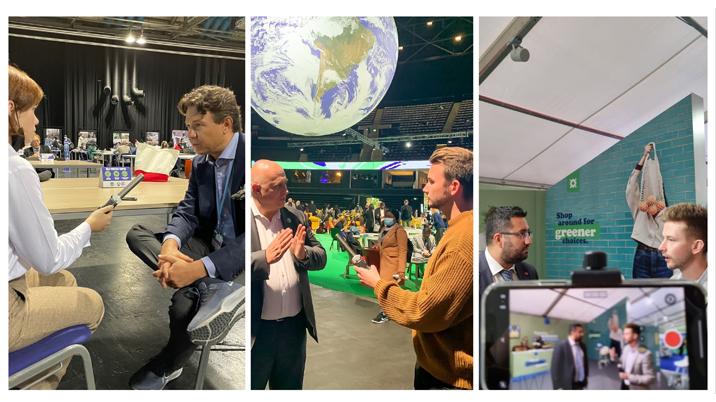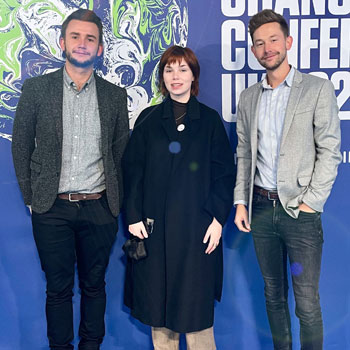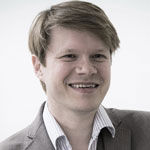
I never thought I’d see the day that I’d be submitting an expenses claim for a rickshaw ride across the Clyde Arc in Glasgow.
It was the penultimate day of COP26. Most of the world leaders and celebrities had already returned home, as had the rest of my team who were now reporting on the developments remotely (on account of there not being enough rooms left in the city to accommodate all three of us for the full two weeks). We had reached the business end of the climate talks and I was recording a final flurry of interviews live from the SEC Glasgow. Inevitably, one of my morning chats had overrun, leaving just ten minutes for me to make what was realistically a 30-minute walk between the ‘Blue Zone’ and the ‘Green Zone’ for a video interview with Nigel Topping, the UN’s high-level climate champion, no less.
In pedalled Mateusz, an Edinburgh-based software developer who had taken on some part-time work as a rickshaw rider under a local green jobs scheme running throughout the two-week summit. Thanks to Mateusz’s herculean effort (I probably should’ve forewarned him about the weight of my filming equipment), I made it to the interview in time. Needless to say, I paid him well and I’m eternally grateful to our accounts team for taking sympathy with the extenuating circumstances noted on my reimbursement form.
COP26 represents edie’s most successful period ever in terms of audience numbers.
Seizing the opportunity
COP26, described by Prince Charles as “the last-chance saloon” to save the world from runaway climate change, was a journalistic experience like no other. Even for myself, edie’s content editor Matt Mace and senior reporter Sarah George – who have more than 20 years’ experience covering sustainability and climate issues between us – there was no preparing us for the scale and intensity of this event, and the unpredictability of its outcomes.
Having become so used to working from home and reporting exclusively from virtual events, it would have been easy for us to feel overwhelmed by the 40,000+ delegates that flocked into Glasgow over those two weeks in November, and for our small content team – reduced to its current size as a result of Covid – to become lost among the hundreds of international media outlets and competing news crews rushing from hall to hall. But, I’m proud to say, we didn’t. In fact, COP26 represents edie’s most successful period ever in terms of audience numbers (website users, page views and report downloaders) along with sponsored content revenue.
Much has already been written about whether or not COP26, and the resulting Glasgow Climate Pact, resembles a ‘success’ for the planet. But rather than reverting to type and analysing the environmental fallout of it all, I thought I’d share a few insights and reflections as to how edie was able to turn the challenge of reporting on this global mega-event into a unique opportunity to grow our B2B audience, evolve the brand, and bring the team closer together.
1.5 degrees of separation
From the moment we boarded a special ‘climate train’ up to Glasgow filled with the likes of youth activist Greta Thunberg and European Commission Vice-President Frans Timmermans, one thing that surprised us about COP26 was the way this event levelled out the vast playing field of politicians, business leaders and the media in a way that no previous global summit has. Exclusive deals struck between the organisers and Scottish-owned food and drink brands saw everyone from Nicola Sturgeon to Leonardo DiCaprio having to survive off the likes of Irn-Bru and Scottish broccoli crisps (surprisingly tasty). Meanwhile, limited hotel rooms across the city forced many senior delegates into makeshift accommodation – one CEO who shan’t be named arrived late to an interview with us because they were “dealing with a rat” in the hallway of their hostel. In a strange way, this grounding of people across all demographics and levels of seniority reinforced the feeling that we’re all in the same boat when it comes to tackling climate change, and that feeling came across in various ways through edie’s content.
It’s humbling to look back at what we achieved as a team. Over the 15 days of the climate summit, we published more than 100 COP26-focused articles; exclusively interviewed more than 70 business leaders, politicians, environmental professionals and climate activists; and conducted 13 live video interviews with climate leaders and experts ranging from former Unilever CEO Paul Polman to Formula 1 champion-turned sustainability entrepreneur Nico Rosberg. It was another former racing driver, America’s Bobby Unser, who famously remarked “success is where preparation and opportunity meet”, and that was very much the case for edie at COP26.
Our preparations took shape several months prior to the summit. With Covid restrictions still in place across the world at the start of the year, we launched the Countdown to COP26 Festival – a six-month programme of themed articles, interviews, reports and online events which effectively planted our flag in the ground as the go-to COP26 resource for businesses in the run-up to the summit. The festival of activity was a huge driver of web traffic, and crucially it secured headline sponsorship from Virgin Media O2 along with several other commercial partnerships which made up a significant portion of our brand revenue for the year.
The festival of activity was a huge driver of web traffic, and crucially it secured headline sponsorship from Virgin Media O2.
Core exercises
The key to edie’s growth in recent years, and something which ultimately underpinned the brand’s success at COP26, is undoubtedly our collective focus on building, nurturing and empowering our core audience of sustainability and energy professionals. This is encapsulated through the evolution of our Leaders Clubs – two communities of senior sustainability and net-zero professionals which we launched pre-pandemic and successfully pivoted from free to paid (recurring) membership models in mid-2021. By effectively ringfencing these core audience groups and reinforcing a sense of personal connection with them through bespoke content and virtual events, our club members have in turn become an invaluable resource across the brand – whether it be through taking part in focus group discussions which help shape our proposition, sharing our content across their organisations and networks, or paying to attend events and enter awards schemes.
This played out at COP26. When transitioning from free to paid, we recruited ten ‘Founding Members’ for each club – a selection of influential industry leaders who helped us shape the new membership proposition and raised awareness of the offering across their social networks, in return for free membership (an approach which proved invaluable for the initial uptake of paying members). Rather fortuitously, one of these founding members went on to take up a secondment at the UN’s Race to Zero business initiative, an official COP26 campaign. It was our pre-existing relationship with this core audience member that led to us becoming the only business media partner for Race to Zero – an official stamp of approval which made it a lot easier for us to gain access to all areas of the summit and helped us secure a number of high-level interviews over the two weeks.
It was our pre-existing relationship with this core audience member that led to us becoming the only business media partner for Race to Zero.
Generation Love Island
Another interesting development which played out at COP26 was the expansion of audience demographics we are experiencing as a brand. From single-use plastics to net-zero emissions, climate change has cemented itself as a mainstream issue in recent years, and that was clear to see at this event. Google recently revealed that “What does COP26 stand for?” was the fourth most-searched question of 2021, above “When will I get the vaccine?” in fifth, and (I’m pleased to report) “When does Love Island finish?” down in 10th. Clearly, people are interested – if still uninformed – about the climate emergency and what’s happening about it.
The biggest surge in interest in our space has been seen among younger generations. Even prior to COP26, edie had witnessed a 59% year-on-year increase in the number of 18-24 year olds visiting the website between 2020 and 2021 – an astonishing statistic. Similarly, there has been significant growth in the number of our members working in junior and middle-management environmental roles – nominations for the 2022 edition of edie’s 30 Under 30 initiative (a community of up-and-coming professionals which acts as a feeder scheme for the aforementioned Leaders Clubs) are up by more than 200% compared with when we first launched the scheme in 2019.
How could we cater for this change in audience demographics without alienating other segments or spreading ourselves too thinly as a brand? For us, an ideal medium has been podcasts. Indeed, the latest Stitcher Podcasting Report notes that podcast listeners are now the fastest growing media audience, and – unsurprisingly – this upward trend in listenership is primarily driven by Gen Z. With this in mind, we saw podcasts as our real differentiator at COP26.
COP26 broke down barriers, engaged new audiences, and ultimately laid the foundations for success.
Breaking down barriers

COP26 Covered – a spin-off from edie’s long-running Sustainable Business Covered series – was a daily podcast show broadcast live from various locations across the summit, including the team’s Airbnb (a student flat situated just down the road from the SEC which the occupiers had decided to cash in on for the week). By combining an informal, behind-the-scenes tone with high-level interviews and in-depth analysis, our podcast effectively recreated the COP26 experience for our audience, many of whom were unable to attend in-person. The show, which formed part of Virgin Media O2’s ongoing sponsorship package, ended up charting at #12 on Spotify and held a spot in the top 50 on iTunes for the duration of the event – making it the most popular climate-focused podcast over that period. Incidentally, the ‘Youth and Public Empowerment’-themed episode, which saw Matt join one of several youth-driven climate protests in the city centre, was the most popular of them all – underlining this increased interest among younger audiences.
For me, the success of COP26 Covered also symbolises an outcome from the summit which is less tangible but arguably more important than website traffic, podcast listeners and revenue numbers: COP26 brought us closer together and reconnected us with our audience. Living together in that no-frills Airbnb and sharing the daily twists and turns in Glasgow created an even deeper connection between us all. From my pedal-powered interviews, to Matt’s pyjama-based editorial team meetings at 10pm every night, to Sarah’s daily quizzes and challenges which played out on the podcast – COP26 broke down barriers, engaged new audiences, and ultimately laid the foundations for success which no one of us could achieve alone. Hopefully, the same COP26 outcomes can be said for our planet in time to come.
This article was first published in InPublishing magazine. If you would like to be added to the free mailing list, please register here.












